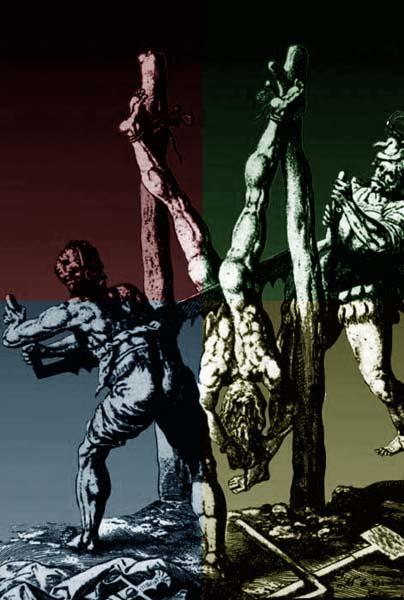The Big Book of Pain: Torture & Punishment Through History (56 page)
Read The Big Book of Pain: Torture & Punishment Through History Online
Authors: Daniel Diehl
The punishment of the spiked barrel is fairly straightforward. A victim would be stripped naked and forced into a cask (such as those pictured here) with hundreds of inward-facing spikes. The cask would then be sealed and rolled down a hill or around the town or even thrown into the ocean to be tossed and rolled and thrown by the waves crashing on the shore. It should be apparent that there would be little hope of surviving such an ordeal.

There is not much that needs to be said about the torture of the saw after examining the accompanying illustrations. The implement pictured below is a common four-hand twoman saw used by woodsmen and carpenters through the centuries.
History abounds in martyrs who suffered this fate, one that may be worse even than being burned at the stake with a slow, small fire, or being repeatedly dipped into boiling oil. Owing to his inverted position, which assures ample oxygenation of the brain and impedes the general loss of blood, the victim does not lose consciousness until the saw reaches the level of the lungs or the heart.
The Bible (II Samuel 12:31) tells us that David exterminated the inhabitants of Rabbah by putting man, woman and child ‘under saws, and under harrows of iron, and under axes of iron, and made them pass through the brick-kiln’.

Perceived (along with the axe and the stake) as a method of execution to be wielded by the righteous, the saw was often meted out to homosexuals of both sexes though predominantly to men. There are various records of this sort of gruesome punishment being carried out in Spain, Germany, France and Italy – among others – until as recently as the nineteenth century.
The images above (based on a woodcut done by Lukas Cranach in 1548) and on the following page clearly show this method of torturous execution in action.

I Thought Edison Invented That
Management Secrets from History
Eat Thy Neighbour: A History of Cannibalism
Tales From the Tower of London
Elbert Hubbard: Common Sense Revolutionary
How Did They Manage?
Siege: Castles at War
Medieval Furniture: Plans & Instructions
Medieval Celebrations
Constructing Medieval Furniture
First published in 2008
This edition published in 2011
The History Press
The Mill, Brimscombe Port
Stroud, Gloucestershire,
GL5 2QG
This ebook edition first published in 2012
All rights reserved
© Mark P. Donnelly & Daniel Diehl, 2008, 2011, 2012
The right of Mark P. Donnelly & Daniel Diehl, to be identified as the Author of this work has been asserted in accordance with the Copyrights, Designs and Patents Act 1988.
This ebook is copyright material and must not be copied, reproduced, transferred, distributed, leased, licensed or publicly performed or used in any way except as specifically permitted in writing by the publishers, as allowed under the terms and conditions under which it was purchased or as strictly permitted by applicable copyright law. Any unauthorised distribution or use of this text may be a direct infringement of the author’s and publisher’s rights, and those responsible may be liable in law accordingly.
EPUB ISBN
978 0 7524 8279 8
MOBI ISBN
978 0 7524 8278 1
Original typesetting by The History Press
Ebook compilation by RefineCatch Limited, Bungay, Suffolk
Table of Contents
SECTION I: TORTURE: MOTIVES, METHODS AND MADNESS
SECTION II: A HISTORY OF TORTURE
1 Torture in the Ancient and Classical World
2 Torture in the Medieval World
3 Torture in the Age of Reason
4 Reforms of the Eighteenth and Nineteenth Centuries
SECTION III: AN ENCYCLOPEDIA OF TORTURE
1 Torture by Burning and Branding
2 Torture by Crushing, Smashing or Breaking
3 Torture by Cutting, Piercing, Tearing and Impaling
5 Torture by Public Display, Shame and Humiliation
6 Torture by Stretching & Suspension